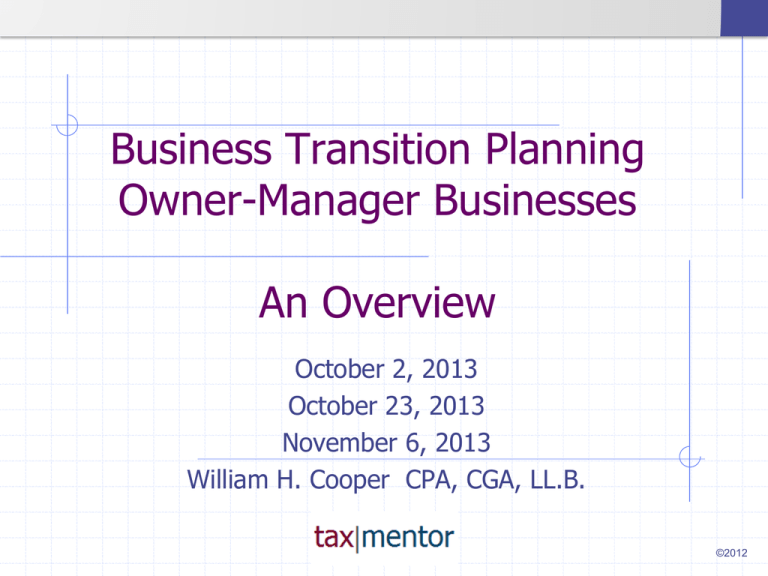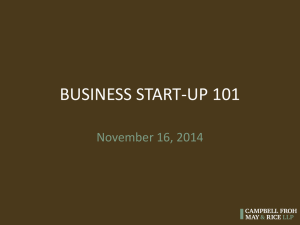the PowerPoint
advertisement

Business Transition Planning Owner-Manager Businesses An Overview October 2, 2013 October 23, 2013 November 6, 2013 William H. Cooper CPA, CGA, LL.B. ©2012 When was Last Time your Client did a Will? • Step One: Get their Will and read it • Does it make sense given the current family dynamics – consider Alter Ego Trusts, Joint Spousal Trusts and Testamentary Spousal Trusts • You’re not just a number cruncher – you’re a family business counsellor • If you don’t do it – who will? ©2013 ©2012 What is Going on with Client’s Family? • Are relationships solid, shaky or broken – who is in charge? • There are significant complications under the new BC Family Law Act if your client has settled a discretionary family trust to benefit their adult children – see FLA Commentary • You may not be a lawyer but you probably have a better understanding of your client’s financial and personal affairs than almost anyone else in their life – take the lead • You don’t need to be a lawyer or a family counsellor to help your clients understand the issues – align yourself with competent professionals – tax lawyers – investment advisors – valuation experts - don’t be afraid to admit you don’t know! ©2013 ©2012 What is the Business Transition Plan • Does your client have a Transition Plan? • If not, is their Will sufficient? If not, talk to your client • With no plan the only one who gets rich on the death of your client is the lawyers! The kids won’t be happy and you may lose a client! • Get your client to consider succession of their business • Without a proper plan in place the family can be torn apart with infighting over family assets after the passing of the parents – business stalemate may lead to Wills Variation and delay in estate distribution ©2013 ©2012 Basic Business Transition Scenarios A. B. C. D. The The The The Business Liquidation Family Transition Employee Buy-Out Arm’s Length Sale ©2013 ©2012 Basic Business Transition Scenarios A. The Business Liquidation • • • • • • Conversion and cashing in of the operating business to an investment business The operating business phases out due to obsolescence or loss of market share while no one is watching Cash in CGE while business still operating Consider “Pipeline Strategy” as exit – see resent CRA/ TCC pronouncements to limit tax payable by estate Consider life insurance and use of CDA Principal should sell illiquid investment assets ©2013 ©2012 Basic Business Transition Scenarios B. The Family Transition • Will apply in many cases where at least one member of • • • • • • the family has taken an interest in the business operations Consider if the next generation up to the task Competing siblings can’t run a business Consider business split while under parents’ control – s.55 Typically a spin-off of redundant or investment/cash assets is made to investment/holding company Separate passive retirement fund to protect parents’ retirement Consider CGE crystallization as pre-paid insurance ©2013 ©2012 Basic Business Transition Scenarios C. The Employee Buy-Out • • • • • Works in limited circumstances but can be useful where no logical arm’s length buyer for the business – e.g. construction businesses not saleable except to insiders Long term planning required – consider ESOPs, SARs and bonus program – “golden handcuffs” Arm’s length minority shareholdings create marketability problems – be wary! Start early developing key employees – get them under contract Don’t issue shares to employees unless Principals are “sure” ©2013 ©2012 Basic Business Transition Scenarios D. The Arm’s Length Sale • Typically only applies to mature businesses where the business “runs itself” Can the owner go away for a month? If not, arm’s length sale unlikely – or value depressed Set up monitoring systems to facilitate transfer of day to day control Few private businesses ever make it to this level • Clients have unrealistic view of business’ value! • • • ©2013 ©2012 Important Factors for a Business Transition • What are the Family Circumstances? stability of marriages competition between siblings - are kids suitable successors • Who are the Key Employees? are they under contract? do they have “golden handcuffs” to keep them in place? Consider ESOPs, SARs and shareholders’ agreements • Are Key Arrangements Legally Documented? software copyright assignments executed? long-term leases in place to protect operating facilities, etc. trademarks registered, tech licenses in place, etc. ©2013 ©2012 Important Factors for a Business Transition (cont’d) • Does Operating Company Own Assets Preventing Sale? large holdings of redundant or passive/cash/investment assets does ownership of valuable real estate assets limit market of available buyers for the business • If a Family Transition, do Wills Permit Transfer as Contemplated? successor generation owners have little interest in “working their butts off” for the benefit of ne’er do well siblings financial advisors need to be family councillors requires some difficult decision making by the principal ©2013 ©2012 Important Factors for a Business Transition (cont’d) • Significant Family Discord? consider an Alter Ego Trust or a Joint Spousal Trust not just to avoid Estate Duties but to avoid Wills Variation claims implement the will NOW using AETs and JSTs • Split Business into Separate Operating Entities? separate businesses operations and/or investment activities ensure kids don’t have to deal with each other if achieved during lifetime of principals this avoids family discord and s. 55 butterfly problems on a non-pro rata distribution ©2013 ©2012 Important Factors for a Business Transition (cont’d) • Consider an Estate Freeze convert commons to prefs to push value to next generation reduces tax on death of surviving parent consider Family Trust for estate planning flexibility opportunity to crystallize Capital Gains Exemption (CGE) and, with Family Trust, multiply CGEs for future value growth Family Trust buys 21 year deferral of capital gains recognition Family Trust permits tax deferred roll out of companies’ shares pushing deferral beyond 21 years to lifetime of next generation works best with a SHA in place where there are multiple kids as trust beneficiaries and eventual shareholders consider s. 74.4 “designated person” attribution rules ©2013 ©2012 Important Factors for a Business Transition (cont’d) • Consider Wasting Freeze if parents have more assets to live on than they need – stop paying wages or dividends and repurchase the freeze shares if it is timed right there may be no taxable capital gain on the death of the surviving parent works especially well for an investment company earning income subject to RDTOH run tax integration numbers to make sure no tax penalty ©2013 ©2012 Important Factors for a Business Transition (cont’d) • Family Trust Tune-Up? check for 21 year deadline and record it in permanent T3 file determine timing of trust wind-up and strategy going forward roll out of assets under s.107(2) – check if s.75(2) applied confirm residency status of all beneficiaries consider possible roll of opco shares down to holdco implement shareholder agreement before distribution from Trust consider impact of BC Family Law Act on discretionary married beneficiaries ©2013 ©2012 Important Factors for a Business Transition (cont’d) • Consider Crystallizing CGE for Unsaleable Businesses protects underlying value on deemed disposition at death example - a dying business with significant real estate holdings CGE only available while the business is still operating crystallizing CGE amounts to purchase of life insurance policy avoids need for separate holding/investment company should include a review of Minimum Tax, ABIL and CNIL balances get the numbers and balances from CRA before proceeding and do the pro forma tax return consider s. 84.1 in any attempt to cash in CGE where there were non-arm’s length dealings on a transfer of the subject shares ©2013 ©2012 Important Factors for a Business Transition (cont’d) • Spin Out of Opco Investments to New Holdco consider where no substantial outstanding creditor claims isolate investment assets from operational liability issues lets kids run business during parents lifetime with no risk to parents/principals on “keeper or pension assets” in holdco separating businesses into separate legal entities facilitates transition to different kids if more than one kid to retain ownership of opco, parents should implement family Shareholders’ Agreement (SHA) have family meeting to discuss parents’ wishes consider s.55, s. 112(1), Part IV and Part VI.1 on any spin off and cross-redemption of shares leading to intercorporate dividends ©2013 ©2012 Important Factors for a Business Transition (cont’d) • Exit strategy - Key Employees consider establishing an Employee Equity Plan that promises a share in the company’s equity but defers actual share ownership private companies with minority shareholders are bad news key employee equity incentives are good but not when they tie the principal’s hands in dealing with a sale of the business shareholders’ agreement crucial use acquisition holdco to permit deductibility of interest borrowings used to facilitate acquisition consider impact of s.20(1)(c) on interest deductibility in any leveraged buy-out - source of funding is typically opco – holdco/opco amalgamation strategy is essential ©2013 ©2012 Thanks! The foregoing presentation merely provides a reminder of some of the key issues that financial advisors should be discussing with their owner-manager clients who are considering the sale or transition of their owner-managed businesses! Make time for your best clients and work with them to establish a plan! TaxMentor is an online tax resource centre that publishes a monthly owner/manager tax news update with links to tax cases, CRA and Department of Finance publications as well as hundreds of other online tax resources at www.taxmentor.ca ©2013 ©2012







